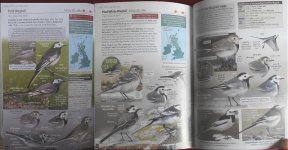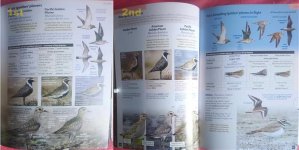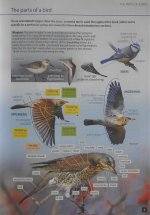John Cantelo
Well-known member
As what follows is a review I thought I'd make it a separate post to the one already running about this book. I've also posted a version of this review on my blog with more comparative photos of the new and old editions of the guide . Although the book still has its critics, I remain convinced that, given the inevitable constraints of size, weight & expense, it's unlikely to be bettered as a photo-guide to Britain's birds.
When “Britain’s Birds: An Identification Guide to the Birds of Britain and Ireland” was published in 2016 it rightly won many accolades since it was, in my view (and that of many others), by far the best photo guide to to British birds available. Arguably, the clever multiple image montages, selection of photographs and the flexible way in which information was presented raised it to be the best photo guide to birds yet published. However, there were some small niggles which were blissfully ignored by most users, caused minor irritation in a few and, at worst, outraged calls for it to be pulped by a handful of perfectionists. So should those happy with the first edition buy this revised version, have those ‘niggles’ been dealt with and how far will it go to satisfying those aiming for perfection?
Many books which promise to be ‘fully revised and updated’ simply don’t deliver (particularly after only a few years) but this one does and does it more thoroughly and comprehensively than any other book I can bring to mind. It really feels like someone has listened to the critics, gone back to the basics, carefully trawled through the book to correct all those (mostly) minor errors, sourced better photos where needed, redesigned the plates where necessary and squeezed in additional photographs where possible. This may not be too far from the truth as Chris Batty (who was rumoured on Bird Forum to have drawn up a list of the original edition’s foibles, is now credited as a ‘consultant’).
The changes to the text start with the ‘Contents’ page which reveals that the order in which the birds are treated has been shuffled around with a handful of bird groups shuffled to make the book still more intuitive to use. For example*Auks*have been shifted to follow ‘Seabirds’ (not*Skuas) and ‘Crakes’ now follow ‘Waders’; small changes but indicative of the attention to detail. The introduction has also been enlarged (from 4 to 6 pages) and redrafted to include a page on bird topography (missing in the original), a useful note on ageing (noting the new ‘roundel’ to indicate years to maturity, useful for gull ID) and an excellent brief introduction to the identification process. Whilst the text descriptions are clearly based on those in the first edition most have been skillfully redrafted sometimes adding new points but often simply making existing*ones easier to read, comprehend and absorb. It helps that the print is easier to read and in many cases, despite being less aesthetically pleasing, the text is now presented on a plain background (rather than over a photograph). As with the photographs these multiple ‘minor’ changes have collectively made a greater impact than is immediately obvious.
Browsing the photographs it quickly becomes apparent the every plate has been examined and, where needed, redesigned and augmented . At times the revision involves no more than shifting images around to add an additional figure, making the text and captions easier to read and adding dates when various plumages might be expected to be seen. It may only involve the substitution of one or two photographs for better ones but for various ‘tricky’ groups (e.g.*Stonechats) it involves a wholesale revision with many additional images. Small touches such as the inclusion of lines linking up images of the same species on pages comparing similar species make for better clarity. Many comparative images of birds in flight (e.g.*yellowlegs) are now consistently set out on a horizontal plane (rather than below one another) which, perhaps surprisingly, seems to make them work better. Similarly, some the plates and tables now have small illustrations to highlight important details (e.g.*‘Lesser’ Golden Plovers*&*dowitchers). Overall too there are more photographs of birds in flight. Happily, the handful egregious errors (e.g. incorrect image of “juvenile*Little Ringed Plover”) and the greater number lesser errors (largely incorrect ageing) seem to have been corrected. Another plus are the captions showing when various plumage variations are to be seen (e.g. juvenile waders & gulls). In addition all plates have benefited from being better printed as they are crisper and brighter in this edition. All of these changes may be individually minor but collectively they make a big impact rendering the book still more user friendly.*
Turning from the text and photographs to the maps, the one area where the first edition was a significant disappointment, it’s again obvious that the critics have been listened to and many corrections made (e.g.*Marsh Harrier). Unfortunately, the problem with the maps stems from their small size and design which has not changed. The design makes it difficult to represent isolated populations in some species, overstates distribution in others and is unsubtle when indicating status across the British Isles. In fairness, this is a problem common to most guides but the ‘Collins BTO Guide to British Birds’ manages to show winter/summer distribution more satisfactorily despite the maps being a third smaller (although these maps are less good at showing regions where birds migrate through and the distribution of birds at sea).* It would also have been an advance to incorporate something along the lines of the 'calendar wheels' of the*BTO*guide.
So returning to my original questions, I believe that those with the first edition would do well to make the small investment to buy this thorough update. This new edition has been a root-and-branch revision such that all the significant errors and virtually all of the minor* ‘niggles’ have been addressed and rectified. It even gives details of the twelve species recorded in the British Isles since the first edition.* Inevitably, some will find fault as the book still fails to give entirely comprehensive coverage in some respects (e.g. frequently seen domestic duck types, exotic wildfowl & some juvenile birds and hybrids) but criticism of such relatively minor omissions should not detract from the bigger picture which is that this remains an innovative and very useful guide with the most useful treatment of British birds currently available.*By striking a good balance between the competing demands of a full treatment of Britain's birds, cost and portability (even if it is bulkier than the first edition with the page count rising from 560 to 576) it stands head-and-shoulders above its rivals (a position unlikely to change any time soon).* However, I remain of the opinion that a European guide based on this book (even if shorn of ultra-rartities) should take precedence over any future revision. I’d finally add that I’d have preferred something other than*Robin*on the cover so that a user (or reviewer) with both could more easily pick up the right volume!
When “Britain’s Birds: An Identification Guide to the Birds of Britain and Ireland” was published in 2016 it rightly won many accolades since it was, in my view (and that of many others), by far the best photo guide to to British birds available. Arguably, the clever multiple image montages, selection of photographs and the flexible way in which information was presented raised it to be the best photo guide to birds yet published. However, there were some small niggles which were blissfully ignored by most users, caused minor irritation in a few and, at worst, outraged calls for it to be pulped by a handful of perfectionists. So should those happy with the first edition buy this revised version, have those ‘niggles’ been dealt with and how far will it go to satisfying those aiming for perfection?
Many books which promise to be ‘fully revised and updated’ simply don’t deliver (particularly after only a few years) but this one does and does it more thoroughly and comprehensively than any other book I can bring to mind. It really feels like someone has listened to the critics, gone back to the basics, carefully trawled through the book to correct all those (mostly) minor errors, sourced better photos where needed, redesigned the plates where necessary and squeezed in additional photographs where possible. This may not be too far from the truth as Chris Batty (who was rumoured on Bird Forum to have drawn up a list of the original edition’s foibles, is now credited as a ‘consultant’).
The changes to the text start with the ‘Contents’ page which reveals that the order in which the birds are treated has been shuffled around with a handful of bird groups shuffled to make the book still more intuitive to use. For example*Auks*have been shifted to follow ‘Seabirds’ (not*Skuas) and ‘Crakes’ now follow ‘Waders’; small changes but indicative of the attention to detail. The introduction has also been enlarged (from 4 to 6 pages) and redrafted to include a page on bird topography (missing in the original), a useful note on ageing (noting the new ‘roundel’ to indicate years to maturity, useful for gull ID) and an excellent brief introduction to the identification process. Whilst the text descriptions are clearly based on those in the first edition most have been skillfully redrafted sometimes adding new points but often simply making existing*ones easier to read, comprehend and absorb. It helps that the print is easier to read and in many cases, despite being less aesthetically pleasing, the text is now presented on a plain background (rather than over a photograph). As with the photographs these multiple ‘minor’ changes have collectively made a greater impact than is immediately obvious.
Browsing the photographs it quickly becomes apparent the every plate has been examined and, where needed, redesigned and augmented . At times the revision involves no more than shifting images around to add an additional figure, making the text and captions easier to read and adding dates when various plumages might be expected to be seen. It may only involve the substitution of one or two photographs for better ones but for various ‘tricky’ groups (e.g.*Stonechats) it involves a wholesale revision with many additional images. Small touches such as the inclusion of lines linking up images of the same species on pages comparing similar species make for better clarity. Many comparative images of birds in flight (e.g.*yellowlegs) are now consistently set out on a horizontal plane (rather than below one another) which, perhaps surprisingly, seems to make them work better. Similarly, some the plates and tables now have small illustrations to highlight important details (e.g.*‘Lesser’ Golden Plovers*&*dowitchers). Overall too there are more photographs of birds in flight. Happily, the handful egregious errors (e.g. incorrect image of “juvenile*Little Ringed Plover”) and the greater number lesser errors (largely incorrect ageing) seem to have been corrected. Another plus are the captions showing when various plumage variations are to be seen (e.g. juvenile waders & gulls). In addition all plates have benefited from being better printed as they are crisper and brighter in this edition. All of these changes may be individually minor but collectively they make a big impact rendering the book still more user friendly.*
Turning from the text and photographs to the maps, the one area where the first edition was a significant disappointment, it’s again obvious that the critics have been listened to and many corrections made (e.g.*Marsh Harrier). Unfortunately, the problem with the maps stems from their small size and design which has not changed. The design makes it difficult to represent isolated populations in some species, overstates distribution in others and is unsubtle when indicating status across the British Isles. In fairness, this is a problem common to most guides but the ‘Collins BTO Guide to British Birds’ manages to show winter/summer distribution more satisfactorily despite the maps being a third smaller (although these maps are less good at showing regions where birds migrate through and the distribution of birds at sea).* It would also have been an advance to incorporate something along the lines of the 'calendar wheels' of the*BTO*guide.
So returning to my original questions, I believe that those with the first edition would do well to make the small investment to buy this thorough update. This new edition has been a root-and-branch revision such that all the significant errors and virtually all of the minor* ‘niggles’ have been addressed and rectified. It even gives details of the twelve species recorded in the British Isles since the first edition.* Inevitably, some will find fault as the book still fails to give entirely comprehensive coverage in some respects (e.g. frequently seen domestic duck types, exotic wildfowl & some juvenile birds and hybrids) but criticism of such relatively minor omissions should not detract from the bigger picture which is that this remains an innovative and very useful guide with the most useful treatment of British birds currently available.*By striking a good balance between the competing demands of a full treatment of Britain's birds, cost and portability (even if it is bulkier than the first edition with the page count rising from 560 to 576) it stands head-and-shoulders above its rivals (a position unlikely to change any time soon).* However, I remain of the opinion that a European guide based on this book (even if shorn of ultra-rartities) should take precedence over any future revision. I’d finally add that I’d have preferred something other than*Robin*on the cover so that a user (or reviewer) with both could more easily pick up the right volume!






